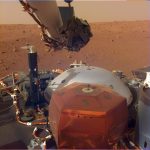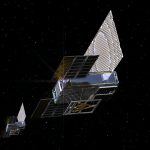InSight Lander Sending Back First Mars Photos0
- From Around the Web, Space
- December 8, 2018
After a long journey, it’s time to get to work.

After a long journey, it’s time to get to work.

After an almost seven-month, 300-million-mile (458 million km) journey from Earth, NASA’s InSight lander successfully touched down Monday, November 26, 2018, near Mars’ equator on the western side of a flat, smooth expanse of lava called Elysium Planitia, with a signal affirming a completed landing sequence at approximately 3 p.m. EST (12 p.m. PST, 8 p.m. GMT). The landing signal was relayed via one of NASA’s two small experimental Mars Cube One (MarCO) CubeSats.

NASA’s Mars InSight probe has landed at what appears to be a beautifully boring location – a fortunate outcome that should expedite the mission’s primary aim of exploring the planet’s interior with seismic and other sensors, scientists said on Monday.

The Nov. 26 live satellite interviews with NASA Administrator Jim Bridenstine (NASA TV media channel, 6-10 a.m. EST) will have one-way audio only. Users will only be able to hear the administrator’s responses, not the interviewers’ questions.

A new analysis of images once thought to show hints of saltwater suggests they actually don’t

InSight will tell us about the planet’s interior, but it’s got to stick the landing first.

Two CubeSats will send data back to Earth of the lander’s fate as they pass the Red Planet

The rover will cache rocks for a future mission to bring back to Earth

The presence of water on Mars has been theorized for centuries. Early telescopes revealed ice caps, and early astronomers noted channels that were hypothesized to be natural rivers or creature-created canals.

The Red Planet is a rich source of perchlorates—chemical compounds used in fertilizer and rocket fuel that are rarely formed naturally on Earth.